
Tour and attractions in Devon & Cornwall
In this long overdue post, we’re finally heading to the beautiful Southwest of England! In the spring of 2023, we spent two weeks exploring the diverse landscapes of the counties of Devon and Cornwall. And the best part: From the lush green hills in Dartmoor National Park to the impressive cliffs at Land’s End, the westernmost tip of England, we were almost continuously greeted by a blue sky dotted with friendly little clouds. Typical English weather? Not at all! Instead, Southwest England was already giving off a hint of summer flair at the beginning of June. The region not only charmed us with its quaint villages but also with its extensive sandy beaches, a well-developed network of hiking trails, and stylish accommodations.
Have you been eyeing a trip to Cornwall and/or Devon for a while now? Or are you looking for vacation inspiration? Wonderful! That’s exactly what I aim to provide in the following lines, offering an overview of our eventful road trip through Devon and Cornwall, sharing the attractions we visited, and revealing my personal highlights.
Devon and Cornwall Road Trip: Route Overview of Our 14-Day Journey
Just like during our hiking holiday in the Lake District National Park in the fall of 2019, this time we also traveled to England by train. Our train journey took us from Zurich via Paris and London to Exeter, the capital of Devon county. There, we rented an electric car for our 14-day journey through Devon and Cornwall. Including the days of arrival and departure, with an overnight stop in London each time, we were on the road for a total of 17 days.
In principle, one could make it from Zurich to Exeter by train in one day. However, I find the journey there and back much more relaxing with a stopover each way. Plus, we took the opportunity to explore different London neighborhoods for half a day each during our journey there and back, thanks to strategic hotel choices, and to check out the trendy London restaurant scene. This flexibility to incorporate stopovers as desired is one of the great advantages of train travel, in my opinion.
Thanks to a very well-developed train and bus network, one could also complete the round trip through Cornwall and Devon entirely by public transportation. This saves the thrill of navigating the famously narrow Devon lanes. We placed a higher value on flexible daily planning and therefore deliberately chose to rent an electric car.
The route of our journey through Devon and Cornwall, as well as all accommodations, attractions, and other highlights we visited, are located on the following map. The individual stages were as follows:
- 1 night in London
- 3 nights in Dartmoor National Park
- 2 nights at Mounts Bay
- 2 nights in Padstow
- 4 nights in Plymouth
- 3 nights in Exmouth
- 1 night in London
Stage 1: Via Paris and London to Dartmoor National Park
Our journey to Devon/Cornwall began on a Friday morning at 07:34 AM at Zurich station. By now, we feel almost “at home” on the Zurich – Paris route and have also got the station change from Paris Gare de Lyon (arrival of the TGV from Switzerland) to Gare du Nord (departure of the Eurostars to London) well under control. Nevertheless, for this trip, we consciously did not book the direct Eurostar connection but instead deliberately planned a good three-hour break in Paris. This way, even train delays wouldn’t immediately shake up the relaxed start to our vacation.
But everything goes according to plan for us, and London greets us at 4:00 PM with steel-blue skies. After checking in at the Hotel The Westbourne Hyde Park (affiliate link) within walking distance to Paddington Station, we take advantage of the beautiful spring weather for a city walk through Kensington Gardens into the Kensington district. There, I purchase the eighth volume of the Seven Sisters series, which was released just in time for my vacation, in a bookstore and then stroll back to our hotel via Notting Hill. In the evening, we have reserved a table at the green Michelin-star awarded Restaurant Apricity and toast to the vacation with London Amber Vermouth & Tonic.
The next morning, we embark on the last train leg from Paddington Station to Exeter. The journey takes just over two hours and is significantly faster than traveling the same distance by car. In Exeter, we have reserved our rental car at the local Hertz agency located in the Marsh Barton industrial area. The rental process is straightforward, and before I know it, I am following the narrow, winding, and green-hedged South English country lanes towards Dartmoor National Park.
We combine the drive to our first stage stop in Dartmoor National Park – the Gidleigh Park (affiliate link) – with a short hike on the “Teign Gorge walk”. A circular hike that starts at Castle Drogo and features beautiful panoramic views over the lush green hillscapes.

On the remaining kilometers to Gidleigh Park, nerves of steel are required. The lane becomes so narrow that passing is impossible except at a few passing places. Fortunately, we do not hit rush hour, and upon arrival, as the destination finally comes into view, I know: The trembling was worth it!

Gidleigh Park is among the top three accommodations of this Devon/Cornwall trip for me. The perfect hideaway for anyone looking for a luxurious break in the countryside. The estate was built in 1928 for an Australian shipowner and converted into a Country House Hotel in 1977. In the early 2000s, the property was extensively renovated. And since the beginning of 2023, the hotel’s restaurant has once again been awarded a Michelin star.
Stage 2: The Green Hillscapes of Dartmoor National Park
Unfortunately, at the time of our vacation planning, only one night was available at Gidleigh Park. However, it provided us with a thoroughly stylish start to the holiday. For the next two nights, we check into the no less impressive Bovey Castle, 20 minutes’ drive away Bovey Castle (affiliate link). This is also a top hotel surrounded by a huge park including a golf course. However, in direct comparison, it cannot match Gidleigh Park in terms of cuisine and service. Moreover, with a total of 64 rooms, it is less intimate than Gidleigh Park, which has only 24 rooms and suites. Bovey Castle is, however, more conveniently located for excursions into Dartmoor National Park.


And that’s exactly what we do in the following two days. Below are the hikes and attractions we visited. I intend to go into more detail about the activities in Dartmoor National Park in a separate blog post, but for now, you can find the GPS tracks of the listed hikes in my Komoot profile:
- Circular walk from the National Park Visitor Centre in Haytor to the Haytor Rocks
- Visit to Becky Falls (entrance fee – current information on opening times and prices can be found here: beckyfalls.com)
- Hike to “Grimspound,” an archaeological site of a Bronze Age settlement and the Hookney Tor
- Stopover in the village of Widecombe-in-the-Moor and lunch at the “On the Green” café



The two full days give us a first glimpse into the fascinating mosaic of landscapes made up of expansive heath and moorland and granite formations (the so-called “Tors”) that have been protected since 1951. And these two days definitely make us eager for more!
Stage 3: From Mounts Bay to Land’s End
Before we explore further corners of Dartmoor National Park, we momentarily leave the green hills behind and head towards the wild-romantic coastal sections of Cornwall. The third stage of our Cornwall/Devon journey takes us to the bustling harbor town of Penzance in Mounts Bay, about 100 miles away. On the roughly two-hour drive there, we make a stop at the “Eden Project“, a huge botanical garden created in a disused china clay pit near St. Austell. The main attractions here are the greenhouses in the shape of geodesic domes, which simulate different climate zones. Since there are also charging stations for electric cars on the associated parking lot, we can fully charge our car while visiting the facility. Quite convenient!
In Penzance, we check into the Artist Residence (affiliate link), a small boutique hotel near the harbor, for two nights.


Right after arrival, we take advantage of the fine weather for an evening walk along the Penzance promenade to Mousehole. In the quaint little coastal village, we enjoy a delicious dinner at the highly recommended restaurant 2 Fore Street. Afterwards, we return the same way. From the promenade, we can also catch a glimpse of St. Michael’s Mount. The tidal island, the British twin of Mont Saint Michel, is impressively illuminated by the last rays of the day, standing out from the sea off the coast.




And it is this very landmark of Cornwall that we visit first thing the next morning. The tidal island is accessible from Marazion Beach, depending on the tide (low or high), by walking (about 10 minutes walking time) via a paved path or by a ferry boat.
During our visit, it is low tide and we are able to walk across. To tour the castle and the rock garden, purchasing an entrance ticket upon arrival at the tidal island is required (single or combined tickets available – more info here: stmichaelsmount.co.uk). In my opinion, both are highly recommended. It’s advisable to allocate about two to three hours for this. To avoid waiting times during the peak season, it’s also wise to arrive early.

Around 11 am, we return to the mainland and set our course towards Land’s End. A detour to the westernmost tip of England is almost mandatory on a Cornwall round trip. And rightly so! The drive from Marazion takes just under thirty minutes. Depending on how much time you have, there are various hiking opportunities available here. Almost all these tours follow sections of the legendary South West Coast Path. We, however, did not visit the other (partly chargeable) attractions of Land’s End. For electric cars, this stop is convenient as there are also charging stations available. The Minack Theatre, another famous Cornwall attraction, is nearby. Those wishing to visit should reserve their tickets in advance.
We instead use the afternoon for a small Road Trip following the A30/B3306 from Land’s End along the beautifully wild coast to St. Ives. Definitely one of the most panoramic roads in Cornwall. Along the way, we stop at Cape Cornwall and the Bottalack Mine for coastal walks. The Bottalack Mine is part of the Cornish Mining Landscape which was added to the UNESCO World Heritage list in 2006. An impressively scenic setting.


By the evening, we reach the lively coastal town of St. Ives. St. Ives would be very picturesque, only it is a classic victim of its own success. Compared to all other places visited in the county of Cornwall, it is definitely the most “overcrowded” here. Thus, after a short walk through the downtown, we quickly move on.
Our next destination: the Restaurant Ugly Butterfly on the spacious Carbis Bay Beach. An absolute hit! In this restaurant, part of the Carbis Bay Hotel, star chef Adam Handling is involved. The sun-drenched location with sea views and the kitchen philosophy, focusing on close collaboration with local producers and comprehensive use of products, perfectly matches our taste.


The Ugly Butterfly restaurant is also the perfect stop to head to the Godrevy Lighthouse for sunset. And what could top off a perfectly splendid day in Cornwall? Right, spotting seals enjoying the last warm rays of the day at Mutton Cove.



Stage 4: Best of Cornwall around the Harbor Town of Padstow
After these two action-packed sightseeing days in the southwesternmost tip of England, our round trip continues to the North Coast of Cornwall around Padstow and Port Isaac. Of course, not taking the most direct route. There are several worthwhile stops along the way, including the Bedruthan Steps. This spectacular cliff formation is located between the towns of Newquay and Padstow along the B3276.
Due to rock falls, access to the beach has been closed since spring 2021. However, from the parking lot/visitor center, after a roughly ten-minute walk on the South West Coast Path, you reach a beautiful viewpoint overlooking the beach and the impressive rock formations. Here again, there is the opportunity to extend the coastal walk as much as you like.



Alternatively, you can head to the picturesque fishing village of Port Isaac and dine at the local Outlaw’s Fish Kitchen (1 Michelin Star). A small, quaint restaurant where an excellent seafood menu is served for a fair 95 pounds.


By evening, we reach the Padstow Townhouse (affiliate link) in the namesake harbor town, led by star chef Paul Ainsworth. This will be our base for the next two days. The Padstow Townhouse blends B&B and boutique hotel vibes. The six rooms are thoughtfully decorated, and the service is top-notch. Another plus: The (very narrow) parking lot includes an electric charging station where we can charge our rental car for free.
The harbor of Padstow, lined with numerous pubs and shops, is just a six-minute walk away. Similarly accessible are the walking paths starting there, which lead to the coast following the Camel River. The perfect backdrop for an evening stroll. And if we hadn’t already indulged at noon, we would have dined at Rick Stein’s Café.



The next day, we take a trip to Cliff Castle “The Rumps”, located at the tip of a small peninsula near Polzeath. We read that, with a bit of luck, one could spot puffins on the cliffs off the peninsula. Various boat tours to this area are also offered from Padstow. The adorable ‘puffins’ seem to be elsewhere that day. However, the detour is more than worth it given the beautiful coastal walkway.



In the evening, we have a reservation at Restaurant Paul Ainsworth at No.6. The Michelin-starred establishment boasts an excellent reputation and delights us with classic cocktails listed in the integrated Ci Ci’s Bar.


Stage 5: Relaxing around Plymouth and its surroundings
After five action-packed sightseeing days in Cornwall, we deliberately slow down a notch. Our round trip takes us from Padstow back into the county of Devon, into the surroundings of Dartmoor National Park. The drive from Padstow to Two Bridges, located in the heart of the national park, takes about 1.5 hours. From here, various circular hikes are possible. We head for Wistman’s Wood, a mystical, elevated oak forest. The unique ecosystem is very fragile and protected. For some time now, paths no longer lead directly through the grove. However, the gnarled oak trees covered in dark moss and lichens look no less impressive from the forest edge.


In the late afternoon, we reach the Boringdon Hall & Spa Hotel (affiliate link), where we will be staying for the next four days. The rooms feel somewhat dated and could use some freshening up. However, the spa area is very lovely, and the absolute highlight is the dining experience at the hotel’s restaurant Àclèaf (1 Michelin Star). We booked this as a package along with the four nights’ stay and thus get to enjoy trying out the entire menu across four evenings (the menu is designed so that it fits perfectly with four dinners). In our opinion, this is a sensational value for money offer that foodies should not miss.



The Boringdon Hall & Spa Hotel is ideally situated for trips into the Dartmoor National Park as well as to Plymouth and further down the coast towards Looe and Polperro. And that’s exactly what we do.
On the first day, we visit the Buckland Abbey, enjoy a delicious lunch at The Sardine Factory in Looe, and stroll through the picturesque fishing village of Polperro.



On the second day, we pack in two hikes. En route to the first tour, we stop at the impressively hilltop Brentor Church. It is on the way to our actual destination – the Lydford Gorge. The deepest gorge in southwest England can be explored on a 5-kilometer circular trail. Along the way, highlights include ‘The White Lady’, a 30m high waterfall, birdwatching stations, and narrow, winding paths following the River Lyd. The area is – like many other attractions – owned by the National Trust, and entrance is charged (More info: Visit Lydford Gorge).



The day’s second hike takes us around the Burrator Reservoir – a reservoir on the southern side of Dartmoor National Park. The circular walk around the lake also takes about 1.5 hours and is mostly flat.

We spend the third full day exploring the nearest destination – Britain’s so-called “Ocean City” Plymouth. We travel there from our hotel by double-decker bus (Line 20A, bus ticket cost: £2.20 one way).
We start our city tour of Plymouth with a detour to Smeaton’s Tower, from where we enjoy a fantastic view over Plymouth and the surrounding area (admission £5). Then we stroll through the historic Barbican district, which delights us with its cobbled streets all the way to the Mayflower Steps Memorial at the old harbor. It marks the spot where the Mayflower set sail for America in 1620. The somewhat hidden Elizabethan Gardens are also worth seeing.



Here are my top three tips for a visit to Plymouth:
- Download the free “Plymouth Trails” app in advance. This app includes various themed city walks, guiding you directly to the major attractions and providing lots of background information (Here’s the app).
- Make a stop at Rockets and Rascals for some good coffee.
- Visit “The Box” Plymouth. The museum offers free entry and provides many fascinating insights into the port city’s multifaceted history (More info: The Box).
Stage 6: the coastal strip between Dartmouth and Exmouth
After four active and pleasurable holiday days in and around Boringdon Hall & Spa Hotel, our Cornwall/Devon round trip takes us back towards Exeter. For the last three days, we have booked a room at Lympstone Manor near Exmouth (affiliate link). Instead of heading straight to the next destination, we take the opportunity for a detour towards the “South Devon National Landscape”. This is a particularly beautiful, protected coastal strip between Plymouth and Brixham. Along the way, we check out the following notable places:
- Wembury Beach; a local favorite with beautiful coastal walking trails.
- The market town of Kingsbridge including a coffee stop at the local Fika Coffee House.
- The market town of Totnes and the nearby Totnes Castle, built by the Normans in the 11th century.
- The coastal area around the octagonal limestone daymark, known as “The Daymark,” near Dartmouth.



And, of course, the area between Lympstone and Exmouth at the estuary of the River Exe, influenced by strong tides. The stylish Lympstone Manor, along with Gidleigh Park and Padstow Townhouse, complete my personal top three accommodations of this trip. The outdoor pool with a beach house is especially cool – and, of course, we are not disappointed in the culinary department either.


Stage 7: the Highlights of the Jurassic Coast
Towards the end of our holiday, we still encounter a day of bad weather, allowing for a relaxed conclusion to our trip. We use the last window of good weather for a detour towards the Jurassic Coast. In 2001, this stretch of coast from Orcombe Point in Exmouth to the Old Harry Rocks near Swanage was included by UNESCO in its list of World Heritage Sites. We first visit the seaside town of Seaton, whose colorful beach huts are a real eye-catcher. Otherwise, the town seems quite sleepy to us, but that might be because the season is just starting at the beginning of June.


In Sidmouth, there’s a bit more action. Here we go on a scenic hike to High Peak, from where the distinctive red cliffs can be fully appreciated.

Practical tips for your round trip through Devon and Cornwall
What is the best time to visit Cornwall and Devon?
The periods from mid-May to the end of June and September are ideal. We traveled at the beginning of June and enjoyed the most beautiful weather (although, of course, there’s no guarantee for this). Moreover, during this time, everything blooms in the most beautiful colors in Cornwall, while the vegetation in the highlands of Dartmoor National Park appears a bit more sparse. The heather blooms here only in late summer. I would rather avoid July/August, as it can get very crowded during the school holidays, and prices tend to skyrocket.
How much time should I allocate for a trip to Cornwall and Devon?
As mentioned at the beginning, we planned 17 days for this trip, including the train journey there and back. We also intentionally set priorities in planning the round trip and did not attempt to cover all beaches or attractions. Despite the relatively relaxed program, we saw and experienced an incredible amount. Therefore, I believe that you can see and experience a lot during a two-week trip. If you have less than two weeks, you would need to set your priorities even more consciously (e.g., focusing on Dartmoor National Park or on South Cornwall).
Which places in Cornwall and Devon should I definitely visit?
Among my top favorites of our road trip are Dartmoor National Park, Godrevy Beach, and the area around Padstow/Port Isaac. And if you like hiking, you should definitely take a closer look at the stages of the South West Coast Path.
What should I absolutely pack for a trip to Cornwall/Devon?
A rain jacket, sunscreen, and light hiking shoes. And very important – the passport! Since Brexit, you can no longer travel to Great Britain with just an ID card.
How much does a round trip to Cornwall and Devon cost?
England is generally not a cheap country to travel – and this applies to Cornwall and Devon as well. The round-trip train tickets cost us around 680 CHF per person. For the electric rental car, we paid 690 CHF for 14 days – where there were hardly any additional costs since we could mostly charge for free. For lodging with breakfast, we paid between 150 and 450 CHF per night as a couple, where we mostly booked higher-class accommodations; there is certainly potential to save here. For a dinner in a restaurant, you should budget between 30 to 80 CHF; again, costs depend on personal preferences. Many of the activities undertaken (hikes) are free. Sometimes, there are entry fees or at least parking fees (including at attractions managed by the National Trust).
Do I need cash for a trip to Cornwall and Devon?
The British Pound is the currency of Great Britain. However, it’s not worth exchanging a large amount of money before the trip or withdrawing a large sum of Pounds from an ATM. We were able to pay by card almost everywhere in Cornwall and Devon. Only at parking meters can the lack of cash be a problem, or alternatively, payment must be made with parking apps. Therefore, I recommend having some cash on hand (primarily smaller denominations) as a backup.





Leave a Reply